Play Anything You Want: Mark Allen and George Herms in Conversation
George Herms has been making art and theater in California for over five decades. He was a founder of the West Coast assemblage movement and traveled in the circles of Beatnik poets and Wallace Berman’s Semina group. Mark Allen founded Machine Project, a nonprofit storegront in Los Angeles’s Echo Park neighborhood, in 2003. Machine Project operates as a classroom, laboratory, performance venue and gallery, blurring distinctions between learning and teaching, amateur and expert, and various forms of artistic and scientific creativity. East of Borneo brought Allen and Herms together because of their impact in shaping the cultural landscape of Los Angeles, and their shared interest in questioning what it means to be an artist.
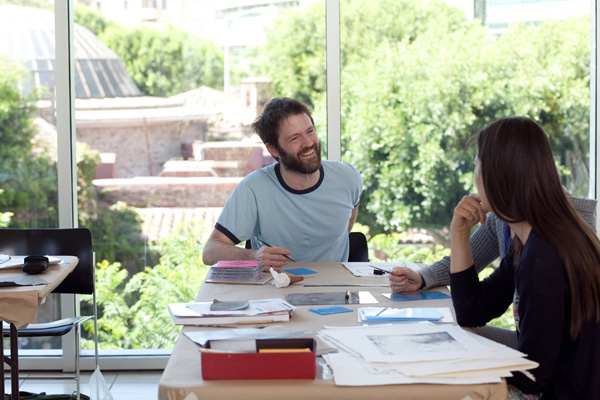
Mark Allen at the Printmaking Workshop as a part of Machine Project’s tenure as Artist In Residence (A.I.R.) at the Hammer Museum, Los Angeles, 2010. Courtesy of Machine Project, Los Angeles.
George Herms: As a child it seemed to me that artists were either put on a pedestal or sent to the funny farm. They never wanted to be part of the community. Yet, when problems in communities escalate, how do you come up with solutions? Well, the muscle of all artists is imagination. So we are very needed. It’s hard to convince people who are blowing the shit out of other countries that we can help them solve problems. That’s a long-winded thanks for your work, Mark! It’s very important. We can’t all go off by ourselves somewhere; we need to interface.
Mark Allen: I think that’s true, and one of the aims of Machine Project is to create a framework for that outside of a formal institution. In LA at the time we opened, it felt like there were a lot of different cultural venues that tended to self-segregate into certain discourses; there might be a literary venue that had poetry readings, or an art gallery that had art exhibits, or a scientific lecture at a college, but they seldom took place in the same venue. And the people who went to one kind of an event seldom seemed interested in the other things. So our idea was to create a space where each week there would be something really different and over time you’d build up an audience who are participating in this transdisciplinary discourse. Sometimes the space acts like an art gallery, but mostly we do events that might range from a night of traditional pirate songs and sea chanteys, to a musical about Erasmus Darwin.
Over time, Machine has also evolved into a kind of art collective where there’s a core group of around thirty to forty artists that tend to be interested in similar sets of concerns, and events are often generated from these concerns. In the last couple of years we’ve started doing more projects off-site, and when we do, we operate very much as a curatorial collective. One recent large-scale project was a one-day event at LACMA where we used the whole museum as a site for performances and workshops. We had a murder mystery, live music, and free haircuts and massages. We did a series of classes on boat building and steel working inside the Richard Serra sculptures, and then we had concerts in there.1In our storefront space we built a fake forest, had pancake breakfasts, and screened 16mm films of bears and cubs. I always felt that LA was great because you can start your thing and then you can build your community out from there; it’s not like you have to necessarily inject into one central discourse. You can set up your own operation.
GH: I’m really mulling this over vis-à-vis my own artmaking, which I’ve been doing every day for the past fifty years. I come from an older school; one person in a studio making something. One time I tried to paint with a friend of mine and we got in a fistfight! So I initially decided that collaborative art and visual art didn’t work, but the collaborative spirit that’s grown in the last few years is really fantastic. In that sense, I think that what you’re doing is probably very close to today’s zeitgeist. But you know, I guess my work probably comes out of the Dada tradition, which was also a very collaborative era; they all worked together and had a lot of fun. And I was in plays and worked for filmmakers, like the wonderful Larry Jordan. He shot a scene on a windy bluff north of San Francisco where he had me stand with a stack of loose-leaf pages. He had me just like throw ’em up in the air and the wind caught ’em all, and it was just this wonderful, gorgeous sight—they looked just like seagulls. Larry took the footage, reversed it, and in the film it’s like I’ve got my hands up like this and all these seagulls come flying toward me. It’s incredible. The first theater piece I did was a seven-minute Genesis myth to rejuvenate the Topanga Players in 1970. The Topanga Playhouse had been dormant for years, and they started up again, so I did a seven-minute Genesis: “The egg of night was floating on chaos, and out of the egg came love. And love, with his arrows and his torch, pierced and vivified all things.” That was the text. I built a large egg out of chicken wire, very funky. It was beautiful. And I could climb inside it and make strange noises. But the theater for me is just a continuation. I treat it as a Joseph Cornell box big enough that you can walk around in. It’s just a continuation of my sculpture, one year at a time.
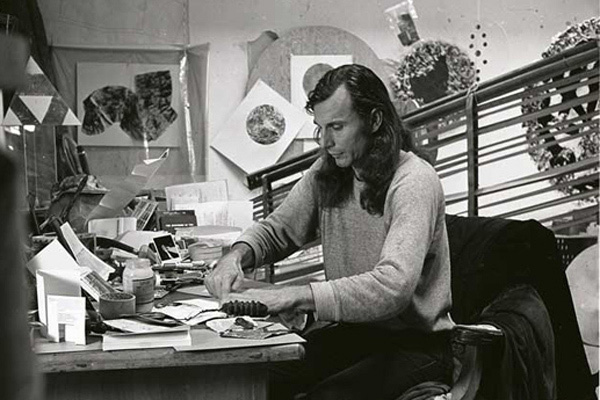
George Herms in his studio, 1977.
MA: George, all the theater projects you’ve been involved with seem like different ways of dealing with the questions, what happens in the theater? Who decides what happens in the theater? And that strikes me as part of a larger question about art in general. How are you invited to do projects?
GH: I’ve been pretty lucky in that I just go where I’m invited, so people know what they’re getting. I make a lot of sounds in my theater pieces. I blow through a garden hose, I shake Venetian blinds, I hit everything—anything that will make a sound. But I’d much rather hear a professional musician play the piano. My problem is I don’t know what I’m doing. I really don’t. I’m an amateur. I’m not a professional. I needed something where I can use my paintings, my imagination, my heart, my spirit, my genitals—everything, something that all of me could go into—and I found the fine arts! I didn’t go to art school. There was a family tradition I had to work against. My grandfather was the mayor of Berkeley, and an entomologist.
MA: Really?
GH: Yes. He worked with wiping out yellow fever, things like that. And my father was an agronomist up in Sacramento and UC Davis, and he was all about agriculture and feeding everyone, so I felt that when my generation came along, the sense was, “Okay you’re healthy, you’re fed, now what?” It’s called culture. But during World War II, anyone with intelligence got shot into the sciences, to the rocket factory, or sent to the college of engineering at Berkeley. So I was sent to Berkeley to become an engineer. I lasted six weeks, till football season was over, and then I went searching. For a while I worked with Remington Rand, on the UNIVAC (Universal Automatic Computer), which was like a giant brain. To get the power of this little computer that I have in my pocket right now, the iPhone, we used to need a machine that was bigger than this wall. But it wasn’t for me and I split. I went hunting in the jungles of Mexico and I lived everywhere trying to find my path in life. My parents said they’d give me a hundred dollars a month if I went back to college, because I never finished engineering, so I took it and bought jazz records and lived on 13 dollars a month, and I came back to Los Angeles.
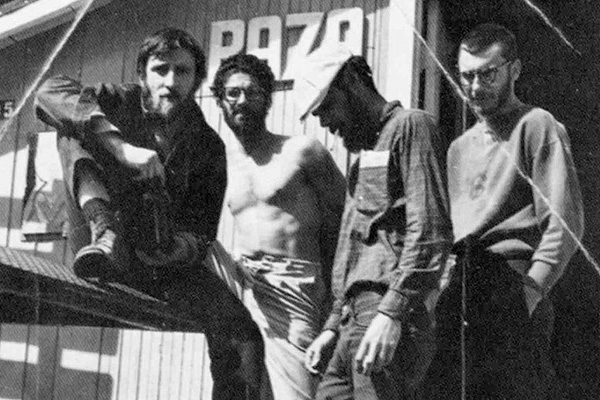
George Herms (right), with Wallace Berman, Robert Alexander, John Reed, Los Angeles, ca. 1955. Courtesy of George Herms.
Luckily, on my twentieth birthday, two artists walked into my life: Wallace Berman and Bob Alexander. They introduced me to a whole worldview that seemed more true to me. They were about ten years older than I was, so they were in full stride, and I just started emulating them. I made “masterworks.” I didn’t know I was supposed to start as an apprentice and then a journeyman where you’d work your way up! Pretty soon I knew seven people in Los Angeles that I could talk to, and I felt really good that there were seven people I could talk to. Those were lovely times—I didn’t have to know anyone’s name, they were all just called “man.” [laughs] It was all so very innocent. It’s like we were all scientists and we would present the results of our experiments. And you’re touching a little of that, Mark. It’s hard to bridge the gap sometimes—you mean, you the funky junk sculptor got along with this guy who makes pristine glass cubes? Yeah, we were friends. We were each other’s audience. We never expected any public to come around.
MA: Making art for other artists is something I think about a lot with our space. Someone in the audience this week might be the person performing next week. We’re trying to render that stage-to-audience relationship a little bit flatter. I sort of feel like every group of friends should start their own art space, and that, to some degree, art’s not something that you need to exalt. It’s more just part of life. Something like: “Oh I had lunch, I checked out some art, I saw a performance, then I watched some TV.” Art’s just part of the general thing. Maybe it’s important to be building your own context for that, so the context for what you do as an artist isn’t just the museum or the galleries in this commercial framework, but the conversation around the community. I really relate to that enthusiasm—making art for other artists.
GH: Yeah, and it’s also dissolving that line between art and life. It seems that the whole twentieth century has been a revolution to overthrow that chastity belt of materials and ideas.
MA: Well, I think something that’s really different today is the sense that artists deal with pretty much everything in the world, even more than they did thirty years ago. So I think it’s kind of natural that the projects we present would be pulled from a lot of different universes. There’s also been a huge change in the way that people use information, driven by the rise of the Internet. Nowadays people go to work and spend half their workday looking up random things on Wikipedia. It’s become very natural for us to use knowledge as a form of recreation. The more obscure things are, the more entertaining they are in a certain sense.
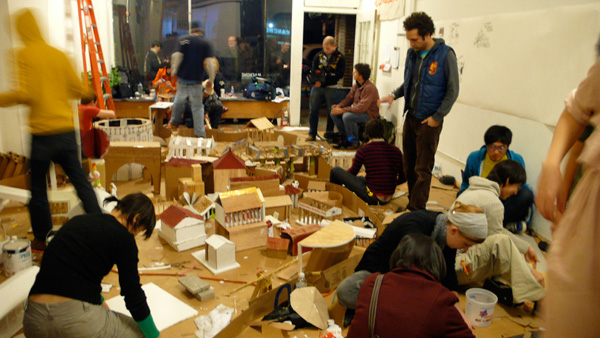
Liz Glynn, The 24 Hour Roman Reconstruction Project, or, Building Rome in a Day, 2008. Participatory performance at Machine Project. Courtesy the artist.
GH: I’m a book person, so before Wikipedia there was the library and you could meander through the library, pull anything off the shelf and go with it. I think that the Dada movement led to a cut-up of poetry and prose and a kind of fragmentation of the mind. That’s a continuous thing. Everything teaches us, absolutely everything, that’s what’s so great.
MA: We were talking briefly about amateurism, and you know how when you’re in your twenties everyone is in a band but they don’t necessarily plan to go professional or attend music school? I don’t know why art can’t be like that too. Making art has become very professionalized lately and I have friends here who might primarily be in a band or are writers, but they’ll randomly do an experiment or performance. I guess I’m trying to say that LA has really interesting people. It’s a very fertile place. I often think about inclusion. If you’re steeped in the arts then maybe you’re not so comfortable with sciences; you go to a scientific lecture and you feel like an asshole because you’re worried that you don’t belong. The saddest thing is when the general public feels like artists are trying to scam them in some way, like, Oh, they’re saying this is art to make me look like a fool. I feel like the most generous people, be they a lecturing artist or someone else, are those who can talk to you about something you were never interested in before but they’re so passionate about it that you get to kind of inhabit their interest. I think that’s a really generous gift.
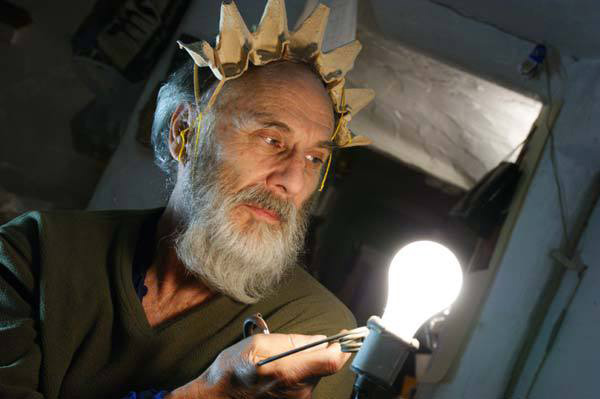
George Herms. Courtesy of the artist.
GH: You know, I’ve delivered babies, I’ve married people, and I’ve buried people. I’ve had a lot flow through me. The real teacher is nature—we all need to study under nature. Mother Nature is the great high priestess of art. She teaches us everything. Whatever it is that catches your interest, you ride that wave: it’s a fixation, an obsession, and you’re totally with it and you ride. The best works will be done at the crest of that wave, and then you continue to work, and then there’s that froth in the end so there will be a lot of other works that are minor to that wave. But you watch those waves come in and you ride the wave. And Machine seems like a way for you to ride that wave.
Lester Young, the great jazz saxophonist, once said, “You can play anything you want, as long as it leads to something else.” And I think that’s it. In my case, the favorite part of whatever I’m working on leads me to the next step. All the accidents that are unique; they become the stairs. Everything that catches my ear or my eye leads me into something and I have just always felt free to pursue it. And so, now who knows? Many of the battles that were fought for freedom of expression have been pretty much resolved. But freedom of expression for me was always like saloon doors, you know? They swung shut and every generation has to kick them open. So I don’t know if your generation will run into that—the closing down on what you want to do and say and express. But I think you’ve certainly got a good support system right now of your peers.